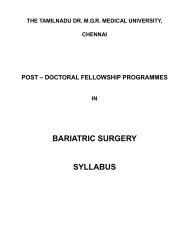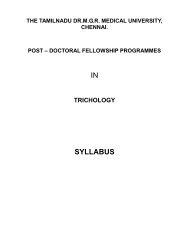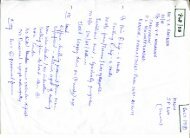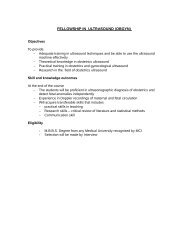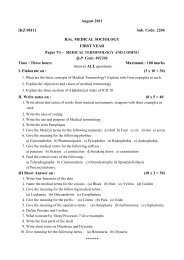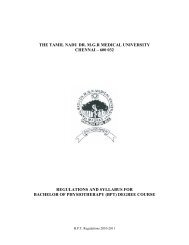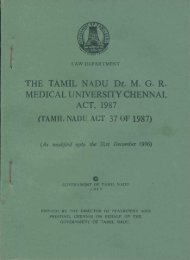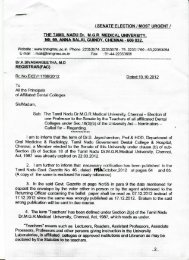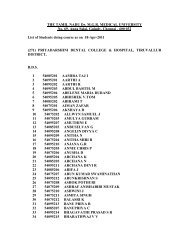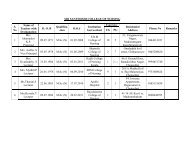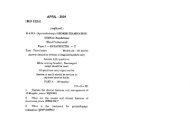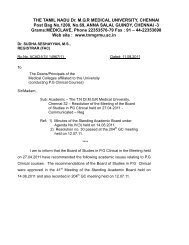2001-2012
2001-2012
2001-2012
Create successful ePaper yourself
Turn your PDF publications into a flip-book with our unique Google optimized e-Paper software.
February 2009<br />
[KU 540] Sub. Code : 4061<br />
SECOND M.B.B.S. DEGREE EXAMINATION.<br />
Revised (Non-Semester) Regulations<br />
Paper I – GENERAL MICROBIOLOGY, IMMUNOLOGY AND<br />
SYSTEMIC BACTERIOLOGY<br />
Q. P. Code : 524061<br />
Time : Three hours Maximum: 100 Marks<br />
Answer ALL questions<br />
Draw Suitable diagrams wherever necessary<br />
I. Essay Questions : (2 x 15 = 30)<br />
1. Describe the morphology of the bacterial cell with the help of a neat<br />
diagram and mention the function of various appendages.<br />
2. Name the bacteria causing sexually transmitted disease. Discuss the<br />
laboratory diagnosis of syphilis.<br />
II. Write Short notes on : (10 x 5 = 50)<br />
1. Hot air oven.<br />
2. Nocardia.<br />
3. Non-sporing Anaerobic infection.<br />
4. Passive immunity.<br />
5. Mycoplasma (lab diagnosis).<br />
6. Louis pasteur.<br />
7. Active immunity.<br />
8. E1 – Tor vibrios.<br />
9. Graft versus host reactions<br />
10. Helicobacter pylori.<br />
III. Short Answer Questions : (10 x 2 = 20)<br />
1. Negative staining.<br />
2. Give two examples for transport media.<br />
3. Arthus phenomenon.<br />
4. Nagler’s reaction.<br />
5. Cold sterilization.<br />
6. Two uses of HLA Typing.<br />
7. Oxidase test.<br />
8. Name the three special species of Brucella.<br />
9. Mantoux test.<br />
10. X and V factors.<br />
*****
August 2009<br />
[KV 540] Sub. Code : 4061<br />
SECOND M.B.B.S. DEGREE EXAMINATION.<br />
Revised (Non-Semester) Regulations<br />
Paper I – GENERAL MICROBIOLOGY, IMMUNOLOGY AND<br />
SYSTEMIC BACTERIOLOGY<br />
Q. P. Code : 524061<br />
Time : Three hours Maximum: 100 Marks<br />
Answer ALL questions<br />
Draw Suitable diagrams wherever necessary<br />
I. Essay Questions : (2 x 15 = 30)<br />
1. Define and classify sterilization. Write in detail about chemical<br />
methods of sterilization.<br />
2. Name the bacterial agents causing pyrexia of unknown origin. Write<br />
the pathogenesis and lab diagnosis of enteric fever.<br />
II. Write Short notes on : (10 x 5 = 50)<br />
1. Flagella.<br />
2. Transduction.<br />
3. Acquired immunity.<br />
4. Monoclonal antibodies.<br />
5. Coagulase test.<br />
6. Elek’s gel precipitation test.<br />
7. VDRL test.<br />
8. Autoclave.<br />
9. Lepromin test.<br />
10. Weil felix test.<br />
III. Short Answer Questions : (10 x 2 = 20)<br />
1. Pasteurisation.<br />
2. Koch’s postulates.<br />
3. Name four selective media.<br />
4. Plasmids.<br />
5. Name four mechanisms of auto immunity.<br />
6. Neufeld quelling phenomenon.<br />
7. M¹ fadyean’s reaction.<br />
8. Name four clostridia causing gas gangrene.<br />
9. Stalactite growth.<br />
10. Runyons classification of atypical mycobacteria.<br />
*****
February 2010<br />
[KW 540] Sub. Code : 4061<br />
SECOND M.B.B.S. DEGREE EXAMINATION.<br />
Revised (Non-Semester) Regulations<br />
Paper I – GENERAL MICROBIOLOGY, IMMUNOLOGY AND<br />
SYSTEMIC BACTERIOLOGY<br />
Q. P. Code : 524061<br />
Time : Three hours Maximum: 100 Marks<br />
Answer ALL questions<br />
Draw Suitable diagrams wherever necessary<br />
I. Essay Questions : (2 x 15 = 30)<br />
1. Define and classify hypersensitivity reactions. Describe type I<br />
hypersensitivity.<br />
2. Describe the pathogenesis, laboratory diagnosis and prophylaxis of<br />
cholera.<br />
II. Write Short notes on : (10 x 5 = 50)<br />
1. Halophilic vibrio.<br />
2. Bacterial capsule.<br />
3. Hot air oven.<br />
4. Conjugation.<br />
5. Malignant pustule.<br />
6. IgE.<br />
7. Adjuvant.<br />
8. Bacterial growth curve.<br />
9. Tric agent.<br />
10. Widal test.<br />
III. Short Answer Questions : (10 x 2 = 20)<br />
1. Satellitism.<br />
2. Milk ring test.<br />
3. Enriched media.<br />
4. Nagler’s reaction.<br />
5. Classification of atypical mycobacteria.<br />
6. Hapten.<br />
7. Name four methods of dry heat sterilization.<br />
8. Name three anaerobic media.<br />
9. Mention three properties of exotoxin.<br />
10. Four organisms causing nosocomial infection.<br />
*****
August 2010<br />
[KX 540] Sub. Code : 4061<br />
SECOND M.B.B.S. DEGREE EXAMINATION.<br />
Revised (Non-Semester) Regulations<br />
Paper I – GENERAL MICROBIOLOGY, IMMUNOLOGY AND<br />
SYSTEMIC BACTERIOLOGY<br />
Q. P. Code : 524061<br />
Time : Three hours Maximum: 100 Marks<br />
Answer ALL questions.<br />
Draw Suitable diagrams wherever necessary<br />
I. Essay Questions : (2 x 15 = 30)<br />
1. Define and classify Antigen Antibody reactions. Discuss Agglutination tests<br />
with clinical examples.<br />
2. Enumerate sexually transmitted bacteria. Discuss Pathogenesis and<br />
laboratory diagnosis of Syphilis.<br />
II. Write Short notes on : (10 x 5 = 50)<br />
1. Capsule.<br />
2. T cells and B cells.<br />
3. Mutation.<br />
4. Extra chromosomal genetic elements.<br />
5. Mechanism of Autoimmunity.<br />
6. Nosocomal infections.<br />
7. Type IV Hypersensitivity.<br />
8. Laboratory diagnosis of pulmonary tuberculosis.<br />
9. Toxigenicity tests for coryne bacterium diphtheria.<br />
10. Differences between Alpha haemolytic streptococci and pneumococci.<br />
III. Short Answer Questions : (10 x 2 = 20)<br />
1. Name four bacteria causing food poison.<br />
2. Inspissation.<br />
3. Super Antigens.<br />
4. Name four Anaerobic methods of cultivation.<br />
5. C – Reactive protein.<br />
6. Hot Air Oven.<br />
7. Sterilization of operation theatre.<br />
8. Graft versus host reaction.<br />
9. Name four live bacterial vaccines.<br />
10. Uses of Gram stain.<br />
*****
February 2011<br />
[KY 540] Sub. Code : 4061<br />
SECOND M.B.B.S. DEGREE EXAMINATION.<br />
Revised (Non-Semester) Regulations<br />
Paper I – GENERAL MICROBIOLOGY, IMMUNOLOGY AND<br />
SYSTEMIC BACTERIOLOGY<br />
Q. P. Code : 524061<br />
Time : Three hours Maximum: 100 Marks<br />
Answer ALL questions.<br />
Draw Suitable diagrams wherever necessary<br />
I. Essay Questions : (2 x 15 = 30)<br />
1. Define sterilization and disinfection. Discuss the methods of sterilization by<br />
moist heat with suitable examples.<br />
2. Enumerate the bacteria causing diarrhoea. Discuss the morphology, cultural<br />
characteristics, pathogenecity and laboratory diagnosis of Vibrio cholera.<br />
II. Write Short notes on : (10 x 5 = 50)<br />
1. Fimbriae.<br />
2. Immuno fluorescence methods.<br />
3. Sources of human infection.<br />
4. Cytokines.<br />
5. Distinguishing factors of T and B lymphocytes.<br />
6. Biochemical tests to identify mycobacterium.<br />
7. Human Leukocyte Antigen (HLA).<br />
8. Toxins and virulence factors of streptococci.<br />
9. Enterotoxigenic Escherichia Coli (ETEC).<br />
10. Listeria monocytogens.<br />
III. Short Answer Questions : (10 x 2 = 20)<br />
1. Name four anaerobic bacteria.<br />
2. Name four chemical methods of sterilization.<br />
3. Enrichment media.<br />
4. Features of transferable drug resistance.<br />
5. Diagram of Immunoglobulin.<br />
6. Name four combined (T & B cell) immunodeficiency disorders.<br />
7. Name four non-organ specific auto immune disorders.<br />
8. Louis Pasteur.<br />
9. Etiology of non-gonococcal (non-specific) urethritis.<br />
10. Mention the various types of hypersensitivity reactions.<br />
*****
August 2011<br />
[KZ 540] Sub. Code: 4061<br />
SECOND M.B.B.S. DEGREE EXAMINATION.<br />
Revised (Non-Semester) Regulations<br />
Paper I – GENERAL MICROBIOLOGY, IMMUNOLOGY<br />
AND SYSTEMIC BACTERIOLOGY<br />
Q.P. Code: 524061<br />
Time : Three hours Maximum : 100 marks<br />
Answer ALL questions.<br />
Draw suitable diagrams wherever necessary<br />
I. Essay Questions : (2 x 15 = 30)<br />
1. Enumerate Hypersensitivity reactions and discuss in detail about Type 4 Hyper<br />
sensitivity reaction and add a note on Shwartzman reaction.<br />
2. Discuss in detail about the etiology, pathogenesis, Lab diagnosis of Bordetella pertussis.<br />
II. Write Short notes on : (10 x 5 = 50)<br />
1. Major Histocompatibility complex.<br />
2. Toxins of Clostridium perfringens.<br />
3. Scrub typhus fever.<br />
4. Abnormal Immunoglobulins.<br />
5. Electron Microscopy.<br />
6. Immunological tolerance.<br />
7. Hemolytic disease of the New born.<br />
8. Relapsing fever.<br />
9. Transposable genetic elements<br />
10. Anaerobic culture methods.<br />
III. Short Answer questions : (10 x 2 = 20)<br />
1. Name 2 Heterophile Antigen – Antibody reaction.<br />
2. Enumerate 4 Liquid culture media for the cultivation of Mycobacterium tuberculosis.<br />
3. Stalactite growth.<br />
4. Name 4 Disorders of Phagocytosis.<br />
5. Name 2 Adjuvants.<br />
6. Name 4 determinants of Antigenicity.<br />
7. Name 4 types of Mutation.<br />
8. Name 4 different types of diarrheagenic Escherichia coli.<br />
9. Satellitism.<br />
10. Voges-Proskauer test.<br />
*****
February <strong>2012</strong><br />
[LA 540] Sub. Code: 4061<br />
SECOND MBBS DEGREE EXAMINATION<br />
Revised (Non-Semester) Regulations<br />
PAPER I – GENERAL MICROBIOLOGY, IMMUNOLOGY<br />
AND SYSTEMIC BACTERIOLOGY<br />
Q. P. Code: 524061<br />
Time: Three hours Maximum: 40 Marks<br />
Answer ALL questions in the same order<br />
Draw Suitable diagrams wherever necessary<br />
I. Elaborate on:<br />
1. Define and classify hypersensitivity. Discuss the mechanisms of anaphylaxis<br />
(10 x 1 = 10)<br />
2. Name the bacterial agents causing pyrexia of unknown origin. Write the<br />
pathogenesis and laboratory diagnosis of acute pyogenic meningitis caused by<br />
any one of them. (5 x 1 = 5)<br />
II. Write notes on: (10 x 1.5 = 15)<br />
1. Anaerobic culture methods<br />
2. Staphylococcal virulence factors<br />
3. Malignant pustule<br />
4. Bacterial flagella<br />
5. Polymerase chain reaction<br />
6. Bacterial growth curve<br />
7. ElTor vibrios<br />
8. Rickettsiae<br />
9. Helicobacter pylori<br />
10. Gaseous disinfectants<br />
III. Short Answers: (10 x 1 = 10)<br />
1. Name two transport media<br />
2. Mention two uses of darkground microscope<br />
3. Give two examples for agglutination tests<br />
4. Give one example for passive artificial immunity<br />
5. List two pathogenic Clostridial species<br />
6. Name the serological tests for diagnosing enteric fever<br />
7. Name the bacterium which causes malignant pustule<br />
8. Name two specific tests for confirming the diagnosis of syphilis.<br />
9. Name the transmitting agent for plague<br />
10. Name the animal model used for the growth of Mycobacterium leprae<br />
*******
[LB 540] AUGUST <strong>2012</strong> Sub. Code: 4061<br />
SECOND YEAR MBBS DEGREE EXAM<br />
Paper I – GENERAL MICROBIOLOGY, IMMUNOLOGY AND<br />
SYSTEMIC BACTERIOLOGY<br />
Q. P. Code: 524061<br />
Time: 180 Minutes Maximum: 40 Marks<br />
Answer ALL questions in the same order.<br />
I. Elaborate on: Pages Time Marks<br />
(Max.)(Max.)(Max.)<br />
1. Define and describe the properties of an Ideal<br />
Disinfectant .Enumerate the various Disinfecting<br />
agents and their applications. 16 30 10<br />
2. Classify Enterobacteriaceae. Write the pathogenesis,<br />
diseases caused and the lab diagnosis of Salmonella<br />
typhii infections. 8 20 5<br />
II. Write notes on:<br />
1. Bacterial growth curve. 3 8 1.5<br />
2. Mutations. 3 8 1.5<br />
3. Nucleic acid probes. 3 8 1.5<br />
4. Mechanisms of antibiotic resistance. 3 8 1.5<br />
5. Innate immunity. 3 8 1.5<br />
6. Immunoglobulin M. 3 8 1.5<br />
7. T. lymphocytes. 3 8 1.5<br />
8. Erythroblastosis fetalis. 3 8 1.5<br />
9. Non suppurative Streptococcal diseases. 3 8 1.5<br />
10. Lab diagnosis of Leptospirosis. 3 8 1.5<br />
III. Short Answers on:<br />
1. Name two selective media for V.cholera. 2 5 1<br />
2. Mention the virulence factors of N.meningitidis. 2 5 1<br />
3. Dosage schedule of Diptheria vaccine. 2 5 1<br />
4. Mention the bacterial spore used in biological warfare. 2 5 1<br />
5. Name two Gram Negative Anaerobic bacilli. 2 5 1<br />
6. IMVIC test. 2 5 1<br />
7. Mention three stages of Plague. 2 5 1<br />
8. Name four non Cholera Vibrios. 2 5 1<br />
9. Mention the components of Pentavalent Vaccine. 2 5 1<br />
10. Name the HACEK group of bacteria. 2 5 1<br />
*******



